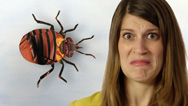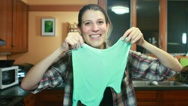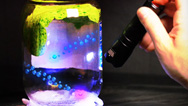Build Your Own Microscope
- By Anna Rothschild
- Posted 01.07.16
- NOVA
Learn how to reveal the tiny creatures living in a puddle using your smartphone, poster tack, and a laser pointer in this episode of Gross Science.
Transcript
Build Your Own Microscope
Posted: January 7, 2016
Hey everyone, today I’m gonna show you how you how to see the teeny tiny creatures living in a drop of puddle water using a microscope that I’m making in my kitchen. And it’s super simple—you can make one, too. I’m so excited.
Ok, to see these organisms you’ll need a smartphone, a laser pointer, some poster tack, a piece of white paper, some clear plastic packaging, a flashlight, and some water from a puddle.
Now, the first thing you’ll need to do is to take the lens out of the laser pointer. And the one I’m using is just a super cheap one from the hardware store that cost something like $3. And I just took the top off and poked at it with a pencil til the lens popped out. Not exactly the most elegant or graceful process in the world, but it worked pretty well.
Anyway, next take some poster tack, roll it into a tube, and circle the lens with it. Then, attach it to the camera on your phone with the more rounded, or convex, side out. Finally, smoosh out the poster tack til it sticks.
This is your microscope. How easy was that?! And we can quickly check that it works by looking at some text with it. But we don’t really want to look at text, we want to look at microorganisms. So now we need to prepare our sample.
Take a piece of white paper and place it on top of a flashlight. Then, cut a small strip of plastic to make a microscope slide, and place that on top of the paper. This particular piece of plastic came from the poster tack packaging.
Next, take a drop of puddle water and place it on the slide. My buddy Greg and I collected this particular sample from a drain pipe. Finally, take another small piece of plastic and place it on top of the droplet to make a slide cover.
Ok, so now that we have our slide we need to focus the microscope, and for this particular sample I found that if I place my phone on this box and prop the flashlight up on a magazine it works just great. So high-tech, I know.
So, now we go into video mode and zoom in on our sample. And look at that! There are so many little organisms swimming around! The larger ones are actually what are called paramecia. They’re these single-celled organisms that beat these little hair-like structures called cilia, and use them to move around and also to eat things like bacteria, and algae, and other microbes. So cool.
Anyway, this is, like, the quick and dirty way to make a microscope. But if you guys would like to try something fancier, I’ll include some links to some awesome tutorials in my video description. But in the meantime though, I’d really love to see what you guys can magnify with your DIY microscopes. So please, send me photos and videos. So far, because this is Gross Science, I’ve tried looking at my own earwax and some dust from under my bed. But, that doesn’t mean you should stop there, so please, please send in your images. I would love to see them. Alright, see you next week!
Ew.
Credits
PRODUCTION CREDITS
- Host, Writer, Editor
- Anna Rothschild
- Special Thanks
- Greg Kestin, Jeffrey Wood, Janet Sonenberg
- Good Times a
- Music Provided by APM
- Original Footage
- ©WGBH Educational Foundation 2016
- Cockroaches
- Freesound/StateAardvark
(used with permission from author) - Squeak Pack/squeak_10
- Freesound/Corsica_S
- Produced by WGBH for PBS Digital Studios
POSTER IMAGE
- DIY Microscope
- ©WGBH Educational Foundation 2016
Sources
Want more info?
Here are some other great DIY Microscope tutorials!
Build a microscope stand for your laser pointer lens scope:
http://bit.ly/1cluVgD
Create a 1000x smartphone microscope with a glass bead:
http://bit.ly/1Soy8Bx
Don’t have a smartphone? Try this water drop microscope from Mr. Wizard:
http://bit.ly/1mlTcg5
Related Links
-

Gross Science
Bizarre stories from the slimy, smelly, creepy world of science.
-

DIY Glow-In-The-Dark Slime
You can make glow-in-the-dark slime with common household items.
-

DIY Subatomic Particle Detector
Here's a simple way to reveal the never ending stream of subatomic particles that's passing invisibly before our eyes.
-

Extract Your Own DNA
Behold your very own DNA in this do-it-yourself science experiment.

